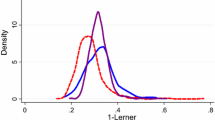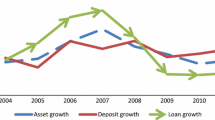Abstract
Despite a consensus that business expansion drives firm effectiveness, extant literature has neglected the exact relationship between business expansion and firm efficiency. Using secondary data from the US and Chinese banking industries, this study explores two efficiencies of exploratory expansion (i.e., investing in new business, outside the scope of the firm’s existing business) and exploitative expansion (i.e., expanding target markets in the existing business)—profitability and marketability. The empirical results reveal that exploratory expansion decreases profitability but increases marketability. Meanwhile, exploitative expansion has no significant effect on profitability, but it can increase marketability. Furthermore, the study reveals that Chinese banks are likely to benefit more from exploratory expansion, whereas US banks would benefit from exploitative expansion.


Similar content being viewed by others
Notes
We thank an anonymous reviewer for suggesting this point.
To test for robustness and enhance confidence in our results (Luo & Homburg, 2007), we reran the DEA with different combinations of inputs and outputs: DEA1 used the whole array of efficiency scores in our study; DEA2 split the efficiency scores for US and Chinese banks and then ran the DEA programming separately; DEA3 lagged the inputs for one year; and DEA4 included the inputs and outputs that were common across Luo’s (2003) and Seiford and Zhu’s (1999) studies. For profitability, the correlations were as follows: DEA1-DEA2 is .768; DEA1-DEA3 is .882; and DEA1-DEA4 is .775. For marketability, the correlations were as follows: DEA1-DEA2 is .916; DEA1-DEA3 is .920; and DEA1-DEA4 is .790. The significant, high correlations affirmed the robustness of the DEA programming results.
References
Argote, L. 1999. Organizational learning: Creating, retaining, and transferring knowledge. Boston: Kluwer.
Bang, V. V., & Joshi, S. L. 2008. Conceptualization of market expansion strategies in developing economies. Academy of Marketing Science Review, 12(4): 1–25.
Barney, J. B. 1991. Firm resources and competitive advantage. Journal of Management, 17: 99–120.
Barreto, I. 2010. Dynamic capabilities: A review of past research and an agenda for the future. Journal of Management, 36(1): 256–280.
Battilana, J., & Casciaro, T. 2013. Overcoming resistance to organizational change: Strong ties and affective cooptation. Management Science, 59(4): 819–836.
Beck, N., Brüderl, J., & Woywode, M. 2008. Momentum or deceleration? Theoretical and methodological reflections on the analysis of organizational change. Academy of Management Journal, 51(3): 413–435.
Berger, A. N., & DeYoung, R. 1997. Problem loans and cost efficiency in commercial banks. Journal of Banking and Finance, 21(6): 849–870.
Berger, A. N., & Humphrey, D. B. 1997. Efficiency of financial institutions: International survey and direction for future research. European Journal of Operational Research, 98(2): 175–212.
Boulding, W., & Staelin, R. 1995. Identifying generalizable effects of strategic actions on firm performance: The case of demand-side returns to R&D spending. Marketing Science, 14(3): 222–236.
Charnes, A., Cooper, W., Lewin, A., & Seiford, L. 1994. Data envelopment analysis: Theory, methodology, and application. Boston: Kluwer Academic.
Charnes, A., Cooper, W. W., & Rhodes, E. 1978. Measuring the efficiency of decision making units. European Journal of Operational Research, 2(6): 429–444.
Chen, C., & Chu, W. 2012. Diversification, resource concentration, and business group performance: Evidence from Taiwan. Asia Pacific Journal of Management, 29(4): 1045–1061.
China Construction Bank. 2010. The development report of Chinese commercial banks in 2010. Beijing: China Financial Publishing House.
Clark, J. A. 1988. Economies of scale and scope at depository financial institutions: A review of the literature. Economic Review, Sept.: 16–33.
Cohen, J., Cohen, P., West, S., & Aiken, L. 2002. Applied multiple regression/correlation analysis for the behavioral sciences. Upper Saddle River: Lawrence Erlbaum.
D’Aunno, T., Succi, M., & Alexander, J. A. 2000. The role of institutional and market forces in divergent organizational change. Administrative Science Quarterly, 45(4): 679–703.
Eisenhardt, K. M., & Martin, J. A. 2000. Dynamic capabilities: What are they?. Strategic Management Journal, 21: 1105–1121.
Fang, E., Palmatier, R. W., & Grewal, R. 2011. Effect of customer and innovation asset configuration strategies on firm performance. Journal of Marketing Research, 48: 587–602.
Fang, E., Palmatier, R. W., & Steenkamp, J. E. M. 2008. Effect of service transition strategies on firm value. Journal of Marketing, 72: 1–15.
Gary, M. S. 2005. Implementation strategy and performance outcomes in related diversification. Strategic Management Journal, 26(7): 643–664.
Grigorian, D. A., & Manole, V. 2006. Determinants of commercial bank performance in transition: An application of data envelopment analysis. Comparative Economic Studies, 48: 497–522.
Hoskisson, R. E., Eden, L., Lau, C. M., & Wright, M. 2000. Strategy in emerging economies. Academy of Management Journal, 43(3): 249–267.
Keister, L. A. 2009. Organizational research on market transition: A sociological approach. Asia Pacific Journal of Management, 26(4): 719–742.
Kim, T. Y., Dobrev, S. D., & Solari, L. 2003. Festina lente: Learning and inertia among Italian automobile producers, 1896–1981. Industrial and Corporate Change, 12: 1279–1301.
Klarner, P., & Raisch, S. 2013. Move to the beat—Rhythms of change and firm performance. Academy of Management Journal, 56: 160–184.
Luo, X. 2003. Evaluating the profitability and marketability efficiency of large banks: An application of data envelopment analysis. Journal of Business Research, 56(8): 627–635.
Luo, X., & Homburg, C. 2007. Neglected outcomes of customer satisfaction. Journal of Marketing, 71(2): 133–149.
Luo, X., Homburg, C., & Wieseke, J. 2010. Customer satisfaction, analyst stock recommendations, and firm value. Journal of Marketing Research, 47(6): 1041–1058.
March, J. G. 1991. Exploration and exploitation in organizational learning. Organization Science, 2: 71–87.
Markides, C., & Williamson, P. J. 1996. Related diversification, core competences and corporate performance. Strategic Management Journal, 15(1): 149–165.
Miller, S., & Noulas, A. 1996. The technical efficiency of large bank production. Journal of Banking and Finance, 20: 495–509.
Miller, S., & Parkhe, A. 2002. Is there a liability of foreignness in global banking? An empirical test of banks’ X-efficiency. Strategic Management Journal, 23: 55–75.
Mishina, Y., Pollock, T. G., & Porac, J. F. 2004. Are more resources always better for growth? Resource stickiness in market and product expansion. Strategic Management Journal, 25: 1179–1197.
Newbert, S. L. 2007. Empirical research on the resource-based view of the firm: An assessment and suggestions for future research. Strategic Management Journal, 28: 121–146.
Rajagopalan, N., & Spreitzer, G. M. 1996. Toward a theory of strategic change: A multi-lens perspective and integrative framework. Academy of Management Review, 22(1): 48–79.
Rubera, G., & Kirca, A. H. 2012. Firm innovativeness and its performance outcomes: A meta-analytic review and theoretical integration. Journal of Marketing, 76(3): 130–147.
Rust, R. T., Lemon, K. N., & Zeithaml, V. A. 2004. Return on marketing: Using customer equity to focus marketing strategy. Journal of Marketing, 68: 109–127.
Seiford, L., & Zhu, J. 1999. Profitability and marketability of the top 55 US commercial banks. Management Science, 45: 1270–1288.
Slater, S. F., & Narver, J. C. 1995. Market orientation and the learning organization. Journal of Marketing, 59: 63–74.
Srivastava, R., Shervani, T., & Fahey, L. 1998. Market-based assets and shareholder value: A framework for analysis. Journal of Marketing, 62: 2–18.
Tidd, J., & Bessant, J. 2011. Managing innovation: Integrating technological, market and organizational change. West Sussex: Wiley.
Zhan, W., & Chen, R. 2013. Dynamic capability and IJV performance: The effect of exploitation and exploration capabilities. Asia Pacific Journal of Management, 30(2): 601–632.
Zhou, K. Z., & Li, C. B. 2007. How does strategic orientation matter in Chinese firms?. Asia Pacific Journal of Management, 24: 447–466.
Zhou, K. Z., Tse, D. K., & Li, J. 2006. Organizational change in emerging economies: Drivers and consequences. Journal of International Business Studies, 37(2): 248–263.
Zhou, K. Z., & Wu, F. 2010. Technology capability, strategic flexibility, and product innovation. Strategic Management Journal, 31(5): 547–561.
Zwillinger, D. 1996. Standard mathematical tables and formulae, 30th ed. Boca Raton: CRC Press.
Acknowledgments
The authors acknowledge the financial support from National Natural Science Foundation Grant of China (71402049, 71172210) and Program for New Century Excellent Talents in University of Ministry of Education of China.
Author information
Authors and Affiliations
Corresponding author
Rights and permissions
About this article
Cite this article
Wang, F., Huang, M. & Shou, Z. Business expansion and firm efficiency in the commercial banking industry: Evidence from the US and China. Asia Pac J Manag 32, 551–569 (2015). https://doi.org/10.1007/s10490-015-9408-1
Published:
Issue Date:
DOI: https://doi.org/10.1007/s10490-015-9408-1




